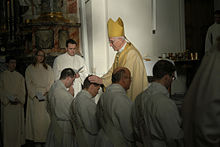Laying on of hands

The laying on of hands is a religious practice. In Judaism semikhah (Hebrew: סמיכה, "leaning [of the hands]")[1] accompanies the conferring of a blessing or authority.
In
A similar practice of laying on of hands is also used in Navajo religious ceremonies.[3]
Jewish tradition
The laying on of hands was an action referred to on numerous occasions in the Hebrew Bible to accompany the conferring of a blessing or authority. Moses ordained Joshua through semikhah—i.e. by the laying on of hands: Num 27:15–23, Deut 34:9. The Bible adds that Joshua was thereby "filled with the spirit of wisdom". Moses also ordained the 70 elders (Num 11:16–25). The elders later ordained their successors in this way. Their successors in turn ordained others. This chain of hands-on semikhah continued through the time of the Second Temple, to an undetermined time. The exact date that the original semikhah succession ended is not certain. Many medieval authorities believed that this occurred during the reign of Hillel II, circa 360 CE.[4] However, it seems to have continued at least until 425 CE when Theodosius II executed Gamaliel VI and suppressed the Patriarchate and Sanhedrin.[5]
Laying on of hands can also refer to the practice of laying hands over one's sacrificial animal (
Christian traditions


In the
The New Testament also associates the laying on of hands with the conferral of authority or designation of a person to a position of responsibility. (See Acts 6:6, Acts 13:3; and 1 Timothy 4:14. Also possibly Acts 14:23, where "ordained"—Greek: χειροτονήσαντες—may be translated "extended the hand".) The use of the laying on of hands for the ordination of church officers has continued in many branches of Christianity.
Anglicanism
Laying on of hands is part of Anglican confirmation,[9] anointing of the sick,[10] and other parts of liturgy and pastoral offices. The rubric in the confirmation service requires the bishop to lay only one hand, symbolising that he has less spiritual authority than an apostle who laid both hands.
The Catholic Church
In the
Eastern Christianity
In
Evangelicalism

In
Baptists
In few
Pentecostalism
Latter-day Saints

Members of the Church of Jesus Christ of Latter-day Saints believe the restoration of Christ's priesthood came about by the laying on of hands by the resurrected John the Baptist to Joseph Smith and Oliver Cowdery in 1829,[16] and laying on of hands is seen as a necessary part of Confirmation.[17] Latter-day Saints lay on hands when ordaining members to[18] to the Aaronic and Melchizedek priesthoods and when setting members apart to serve in other positions in the church.[19] When asked by a member who is ill, two elders of the Church anoint the sick member's head with consecrated olive oil and then lay hands upon their head and as guided by the Holy Spirit, bless them.[20]
African traditional medicine
The San peoples of Southern Africa use the laying on of hands as a healing practice. As described by professor Richard Katz, the healers of the !Kung people lay their hands on a sick person to draw the sickness out of them and into the healer in a "difficult, painful" process.[21]
State use
This section needs additional citations for verification. (May 2014) |
The laying on of hands, known as the
See also
- Anointing
- Exorcism
- Faith healing
- Gifts of healing
- Gift of miracles
- Holy anointing oil
- Hypnosis
- Manual therapy
- Ordination
- Pneumatology
- Priesthood blessing
- Reiki
- Right hand of Christian fellowship
- Snake handling
- Speaking in tongues
- Spiritual gift
- Spirituality
- Superstition
- Thaumaturgy
- Scott Morrison
Notes
- ^ "Strong's Hebrew: 5564. סָמַך (Samak) -- to lean, lay, rest, support".
- ^ "Chirotony", Encyclopaedia Britannica, vol. II (1st ed.), Edinburgh: Colin Macfarquhar, 1771.
- PMID 11224977.
- ^ Nachmanides, Sefer Hazekhut, Gittin ch 4; Rabbenu Nissim, ibid; Sefer Haterumot, Gate 45; R Levi ibn Haviv, Kuntras Hasemikhah.
- ^ "ROMAN IMPERIAL LAWS concerning Jews (329-553)". 19 December 2008.
- ^ Jerusalem Talmud, Hagigah 2:2 [10b]
- ^ Philo, De Specialibus Legibus (The Special Laws), book i, chapter 37, vs. 204.
- ^ Jerusalem Talmud (Hagigah 2:2 [10b])
- ^ "for example: Book of Alternative Services – Anglican Church of Canada, p. 628".
- ^ http://stmarks.byethost9.com/ for example: Book of Alternative Services – Anglican Church of Canada, p. 555
- ^ Walter A. Elwell, Evangelical Dictionary of Theology, Baker Academic, USA, 2001, p. 678
- ^ John H. Y. Briggs, A Dictionary of European Baptist Life and Thought, Wipf and Stock Publishers, USA, 2009, p. 296
- ^ William H. Brackney, Historical Dictionary of the Baptists, Scarecrow Press, USA, 2009, p.525-526
- ^ Bill J. Leonard, Baptists in America, Columbia University Press, USA, 2005, p. 76
- ^ Christopher A. Stephenson, Types of Pentecostal Theology: Method, System, Spirit, OUP USA, USA, 2012, p. 64
- ISBN 978-1-59297-503-7. Retrieved 18 July 2022.
- ^ "General Handbook of Instruction". churchofjesuschrist.org. The Church of Jesus Christ of Latter-day Saints. Retrieved 18 July 2022.
- ^ "General Handbook of Instructions". churchofjesuschrist.org. The Church of Jesus Christ of Latter-day Saints. Retrieved 18 July 2022.
- ^ "General Handbook of Instructions". churchofjesuschrist.org. The Church of Jesus Christ of Latter-day Saints. Retrieved 18 July 2022.
- ^ "Performing Priesthood Ordinances and Blessings, section 18.13.2". churchofjesuschrist.org. Retrieved 18 July 2022.
- ISSN 0091-2131– via JSTOR.
References
- New Bible Dictionary (ISBN 0-85110-630-7)
- Parry, Ken; Melling, David, eds. (1999). The Blackwell Dictionary of Eastern Christianity. Malden, MA.: Blackwell Publishing. ISBN 978-0-631-23203-2.
- Swete, H.B. "Laying on of hands". Archived from the original on 2010-09-03. Retrieved 2007-10-15.
- "Imposition of Hands". Catholic Encyclopedia.
- "Ordination". Jewish Encyclopedia.
- Scott, Gini Graham (2002). The Complete Idiot's Guide to Shamanism. Alpha Books. ISBN 978-0-02-864364-9.
